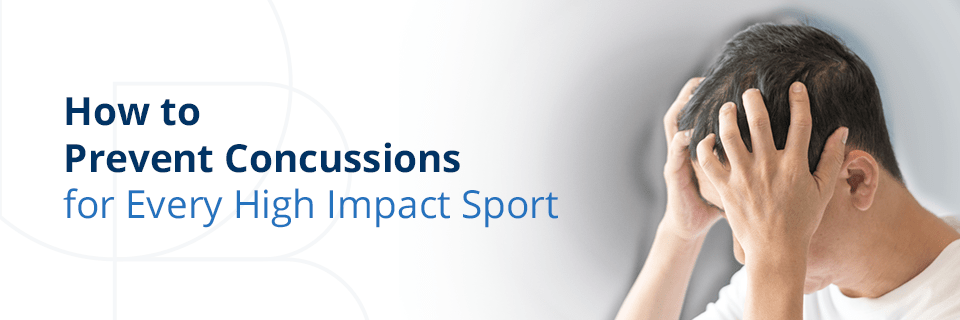
Quick Navigation
- What Is a Concussion?
- What Causes a Concussion?
- Does Age Play a Factor in Concussion Risk?
- How a Concussion Happens in High Impact Sports
- Popular Sports That Cause Concussions
- What Can Be Done to Prevent Concussions in High Impact Sports?
- How to Prevent Concussions in Football
- How to Prevent Concussions in Soccer
- How to Prevent Concussions in Basketball
- How to Prevent Concussions in Hockey
- How to Prevent Concussions in Wrestling
- How to Prevent Concussions in Volleyball
- How to Prevent Concussions in Lacrosse
- How to Prevent Concussions in Boxing
- How to Prevent Concussions in Rugby
- Concussion Symptoms
- Concussion Diagnosis
- Concussion Treatment
- Contact OrthoBethesda
According to the Brain Injury Research Institute (BIRI), athletes in the United States experience anywhere from 1.6 to 3.8 million recreation and sports-related concussions each year. This shocking statistic isn’t just a number. Behind each concussion, there are concerned parents watching in the stands, worried teammates and coaches on the sidelines and a player in need of significant recuperation.
You want the best for your child and their safety during school-organized sports matters. Beyond the protective equipment and game rules, understanding how to prevent concussions in sports is a crucial safety measure. With effective concussion prevention strategies, your child can increase their chances of playing the sport they love without a season-ending injury.
What Is a Concussion?
The Centers for Disease Control and Prevention (CDC) define a concussion as a kind of traumatic brain injury. Most concussions result from a jolt, bump or blow to the head. Though they are not life-threatening, a concussion should be taken seriously, so an athlete can make a full and successful recovery.
Concussions are common among young athletes, with up to 2.5 million teens reporting a sports-related concussion in 2017. This frequency is linked to the types of motion and contact athletes face during practice and games.
What Causes a Concussion?
A sudden jolt can force an athlete’s head and brain to move back and forth quickly. Concussion blows typically last mere moments, but their impact is great. Forceful movement makes the brain twist or bounce within the skull. This jarring motion can cause chemical and metabolic changes in the brain, as well as stretching and damage to the brain cells.
Does Age Play a Factor in Concussion Risk?
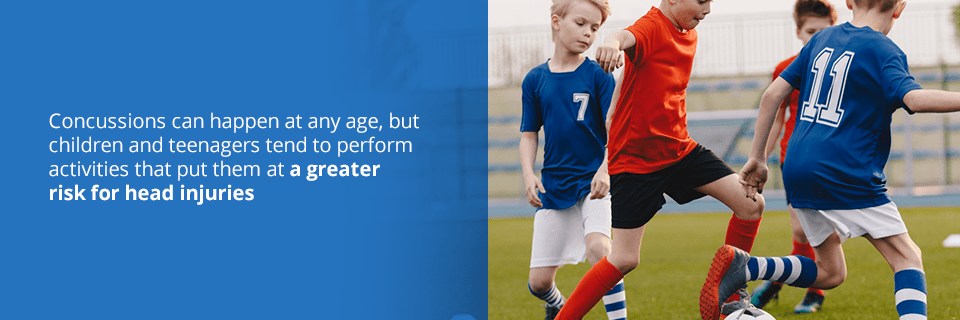
Concussions can happen at any age, but children and teenagers tend to perform activities that put them at a greater risk for head injuries — this may include organized sports, rough play, falling and more. When compared to adults, younger children may be more prone to concussions because their brains are still developing, and they are more susceptible to injury.
How a Concussion Happens in High Impact Sports
According to a study from the American Academy of Pediatrics (AAP), approximately 64 percent of concussions happen during games, and 36 percent happen in practice. Concussions can happen whether an athlete is wearing safety gear or not, though the risk is lower with proper protection.
The AAP identified three common concussion causes among high school athletes:
- Contact with another person: Approximately 62 percent of concussions happen when an athlete makes sudden contact with another player. An example could include a football player making helmet-to-helmet contact with another athlete during an aggressive tackle.
- Contact with a surface: 17.5 percent of concussions occur when an athlete hits a hard surface. A basketball player falling backward and hitting their head on the court floor after taking a charge is an example of this type of concussion.
- Contact with equipment: Approximately 16 percent of concussions happen when a player makes sudden contact with a piece of equipment, like an ice hockey player being struck with a stick.
Though these are common causes, concussions can happen any time an individual receives a rapid, sharp blow to the head.
Popular Sports That Cause Concussions
Some high impact sports have higher instances of concussions given the amount of rough contact during game play. The American Academy of Orthopedic Surgeons reports the following sports to have the highest concussion rates:
- Football
- Ice hockey
- Soccer
- Lacrosse
Other high impact sports that pose concussion risks include the following:
- Basketball
- Wrestling
- Volleyball
- Boxing
- Rugby
Even non-high impact sports can present a concussion risk if a participant is involved in an accident. These sports include:
- Cheerleading
- Golf
- Baseball
- Softball
- Gymnastics
- Swimming and diving
- Cycling
What Can Be Done to Prevent Concussions in High Impact Sports?
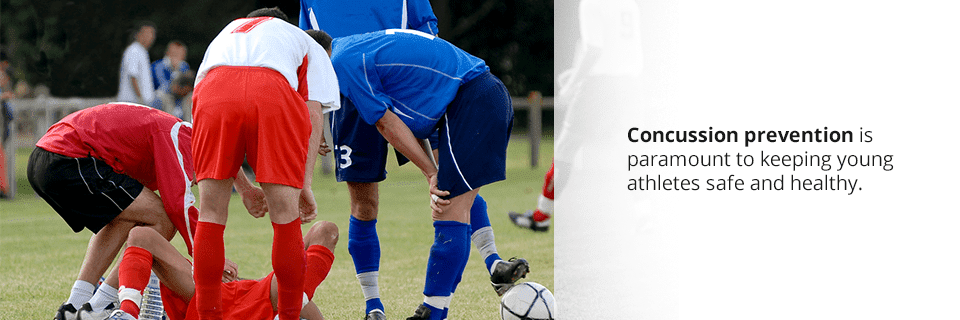
Concussion prevention is paramount to keeping young athletes safe and healthy. It’s most effective to address how concussions can be prevented in sports by breaking down recommendations for each game type.
1. How to Prevent Concussions in Football
College and high school football players experience a high risk for concussions from tackling. According to the CDC, tackling accounts for nearly two-thirds of football concussions. Positions that frequently and receive tackles — such as linebackers and running backs — experience a majority of concussions among football team members.
The following are practical tips to help avoid football-related concussions:
- Ensure players wear helmets that are in good condition and fit well whenever playing or practicing.
- Educate players about the proper way to avoid blows to the helmet.
- Train players on proper safety, sportsmanship and rules, and enforce these principles.
- Do not allow players to make contact with another player’s head or body with their helmet.
- Remove tripping hazards from the field and pad goalposts and other solid equipment.
- Pay special attention to linebackers and running backs during running plays.
- Maintain access to certified trainers during practices and games.
- Limit the amount of direct player contact during practices.
2. How to Prevent Concussions in Soccer

Soccer concussion statistics show a distinct imbalance between male and female players. Female soccer players face an increased risk for concussions compared to male players. Most soccer concussions happen when a player is heading the ball. In these instances, athletes may make contact with another player who is also trying to head the ball or may strike the goalpost or ball with extreme force.
The following are practical tips to help avoid soccer-related concussions:
- Educate players on ways to avoid collisions with other players.
- Ensure players abide by the rules and sportsmanship expectations.
- Do not allow young players to head the ball.
- Remove tripping hazards from the field and protect the goalposts with quality padding.
- Ensure players do not hit other players with their head or make illegal contact.
3. How to Prevent Concussions in Basketball
Basketball is another sport in which female players have a higher concussion risk than males. Most basketball-related concussions happen when a player collides with another player, including during charges and scoring drives.
The following are practical tips to help avoid basketball-related concussions:
- Ensure players understand and follow the rules for safe and fair play.
- Discourage players from hitting other players in the head or using their head to make contact.
- Do not allow dangerous fouling actions that could injure another player.
- Remove tripping hazards and pad the gym walls.
4. How to Prevent Concussions in Hockey
Both field and ice hockey pose concussion risks for players. Field hockey does not allow checking, which eliminates a major concussion hazard. Instead, most field hockey concussions occur when a player makes contact with a hockey stick or ball. In addition, field hockey players are most likely to sustain a concussion while defending or chasing a loose ball.
The following are practical tips to help avoid field hockey-related concussions:
- Ensure players avoid risky stick play like swinging or checking.
- Make sure players understand all safety rules and practice good sportsmanship.
- Remove tripping hazards from the field and pad goalposts.
Ice hockey has a number of additional concussion concerns based on its game play. Nearly two-thirds of ice hockey concussions happen from contact with another player, and the remaining happen during checking. Players in the wing position are especially susceptible to these concussion risks.
The following are practical tips to help avoid ice hockey-related concussions:
- Limit the amount of player contact during practice drills and scrimmages.
- Ensure players have helmets that fit properly and are in good condition.
- Make sure players follow the rules for safe play and practice good sportsmanship.
- Pay special attention to players in the wing position.
5. How to Prevent Concussions in Wrestling
At its core, wrestling is a contact sport that requires sudden movements in close proximity with other wrestlers. More than half of all wrestling concussions happen during takedowns, which have the potential to slam a wrestler’s head into the mat.
The following are practical tips to help avoid wrestling-related concussions:
- Instruct wrestlers on proper takedown techniques.
- Teach wrestlers ways to avoiding hitting their heads and their opponent’s head.
- Make sure wrestlers abide by the rules and sportsmanship expectations.
6. How to Prevent Concussions in Volleyball
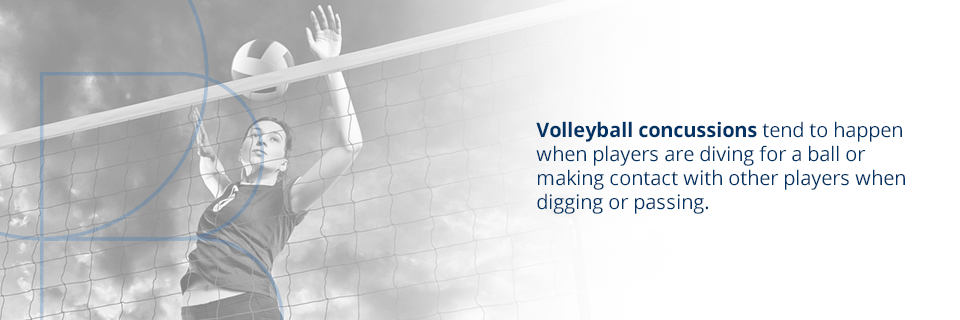
Volleyball concussions tend to happen when players are diving for a ball or making contact with other players when digging or passing. Players in the hitter or setter positions also have the highest risk of concussion.
The following are practical tips to help avoid volleyball-related concussions:
- Instruct players on the proper digging and diving techniques.
- Avoid practice drills that increase a player’s chance of being hit with a ball.
- Remove tripping hazards and pad the net poles.
- Pay special attention to players in the setter and hitter positions.
- Encourage players to call the ball to avoid running into one another.
7. How to Prevent Concussions in Lacrosse
Men’s and women’s lacrosse employ different rules, which affect the concussion risks for each gender. Women’s lacrosse does not allow checking. Accordingly, the greatest concussion risks for female players include contact between a player and crosse while defending or ball handling.
The following are practical tips to help avoid lacrosse-related concussions for women:
- Make sure all players abide by the rules and exhibit good sportsmanship.
- Do not allow players to swing or check around another player’s head.
- Remove tripping hazards and ensure equipment has adequate padding.
Men’s lacrosse does allow checking, which increases the amount of physical contact players have. Most concussions among male lacrosse players stem from player to player contact — especially for midfielders. Common actions that lead to concussions include being body checked, chasing a ball, checking another player and defending.
The following are practical tips to help avoid lacrosse-related concussions for men:
- Instruct players about how to avoid hits to the head.
- Pay special attention to midfielders during games.
- Limit the amount of checking during practice and scrimmages.
- Ensure all players wear a helmet that fits and is in good condition.
- Remove tripping hazards and ensure equipment is well-padded.
- Encourage players to follow the rules and practice good sportsmanship.
8. How to Prevent Concussions in Boxing
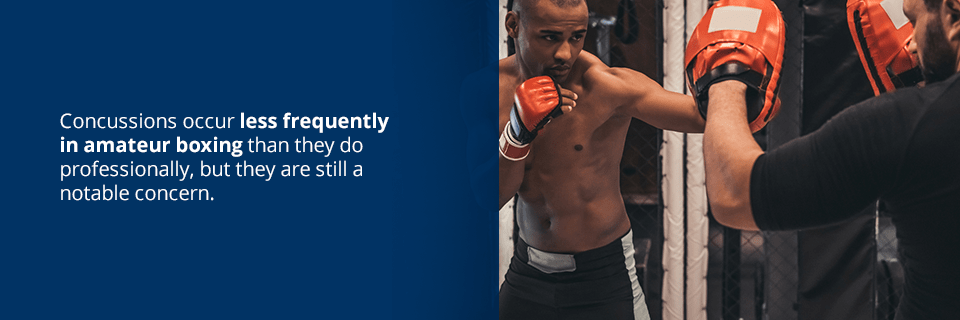
Concussions occur less frequently in amateur boxing than they do professionally, but they are still a notable concern. In fact, amateur boxers face a 13 percent risk of concussion during each match. Shorter matches and certain safety measures help keep amateur boxers safe while participating in a high contact, high impact sport.
The following are practical tips to help avoid boxing-related concussions:
- Encourage boxers to observe all rules and practice good sportsmanship.
- Instruct boxers on the proper ways to block punches and take punches.
- Ensure boxers practice precaution while sparring.
- Make sure all boxers have proper headgear that fits.
- Pay special attention to boxers who have previously had concussions, and do not let them compete until they have fully recovered.
9. How to Prevent Concussions in Rugby
Most rugby players compete without padding and endure high impact, full-body hits. Concussions are a significant concern in this sport as players experience football-like head contact without a helmet to protect their brain. Common actions that lead to violent contact include scrumming, tackling and rucking.
The following are practical tips to help avoid rugby-related concussions:
- Instruct players on the proper rules and safety measures.
- Teach players the correct tackling technique.
- Lead players in exercises that strengthen their neck muscles, like isometric holds.
- Encourage players to wear a mouthguard and headgear.
Concussion Symptoms
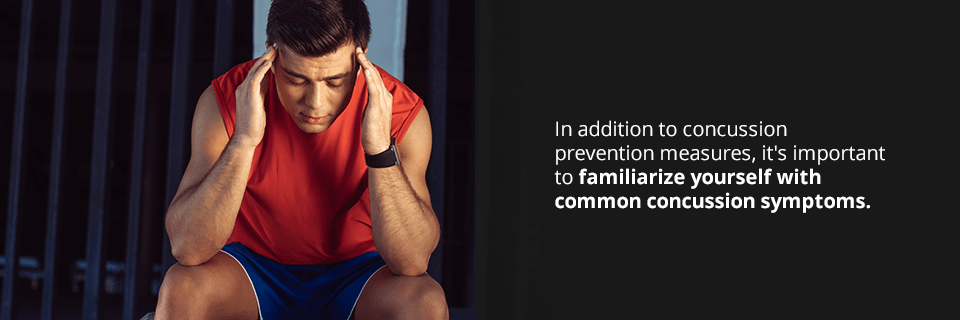
In addition to concussion prevention measures, it’s important to familiarize yourself with common concussion symptoms. The sooner you identify your child’s concussion, the better you can address their needs and support their recovery. Concussion symptoms tend to show up soon after a strong blow, but in some cases, an athlete may not develop clear symptoms for several hours or days.
Depending on your child’s age, it may be more difficult for them to understand and communicate their symptoms. Young children may not comprehend what is happening, and older kids may downplay their symptoms in order to continue playing. In any case, a swift diagnosis is key.
A parent or coach may notice some of the following symptoms if a player has experienced a concussion:
- Increased clumsiness in movement
- A stunned or dazed appearance
- Inability to remember what happened before or after a hard blow
- Confusion about an instruction
- Difficulty remembering instructions
- Confusion about the score, opponent or game
- Slow verbal response time
- Loss of consciousness
- Mood, personality or behaviors changes
In addition to symptoms you notice, a player may report feeling some of the following:
- Confusion
- Difficulty concentrating
- Difficulty remembering information
- Sensitivity to sound
- Sensitivity to light
- Nausea and vomiting
- Headaches
- Head pressure
- Issues with balance
- Dizziness
- Blurred vision
- A feeling that something is “off”
- Feeling sluggish or groggy
If you suspect your child may have a concussion, monitor their symptoms consistently after the jolt. If the symptoms worsen, contact a doctor right away.
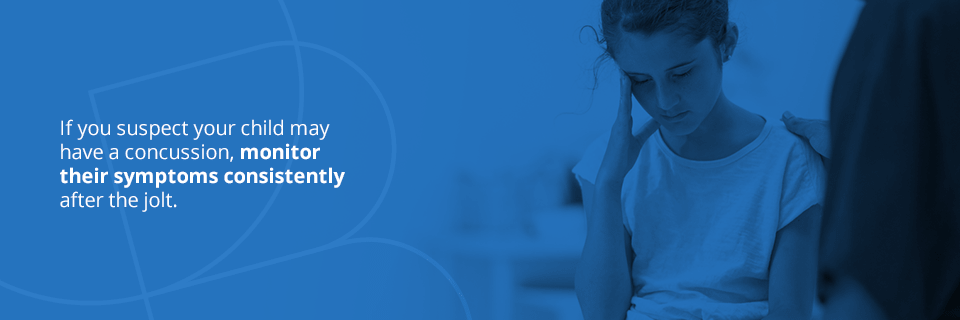
Concussion Diagnosis
Many schools utilize concussion baseline testing to help healthcare professionals make an accurate concussion diagnosis. When baseline testing occurs, a player takes a standardized exam before their season begins. This exam is specially designed to establish a baseline for an athlete’s cognitive abilities when in optimal health, including memory skills, concentration, attention span and more.
A baseline test may also assess the following medical history characteristics, which could impact concussion recovery:
- Previous concussions
- Current or past migraine issues
- Depression and anxiety
- Mood disorders
- Learning disabilities
If the player shows signs of a concussion, a professional can administer the baseline test to measure the effect the injury had on their brain. A player’s post-injury baseline testing results can help determine how long the player will need to recover before returning to normal activities.
In addition to baseline testing, a healthcare professional may order an imaging test or recommend overnight observation. A CT scan may be necessary if a player experiences severe headaches, repeated vomiting, seizures or worsening symptoms. The scans can help identify the severity of a traumatic brain injury as well as determine if there is any bleeding or swelling.
Overnight observations can help monitor a player’s symptoms and how they may be developing. Depending on your healthcare provider’s assessment, you may be able to complete monitoring at home by checking on your child through the night.
Concussion Treatment
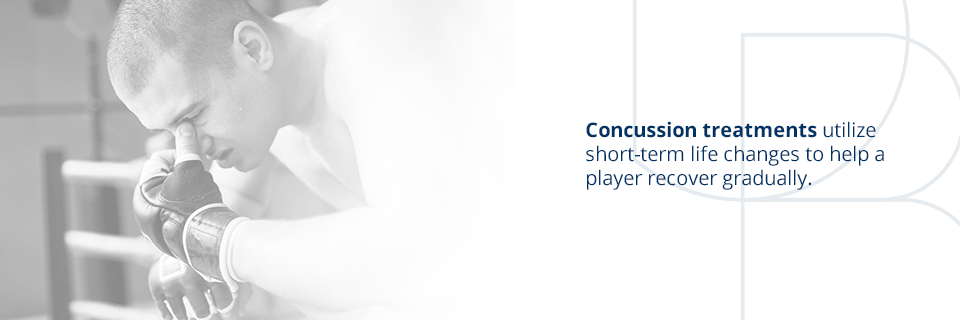
Concussion treatments utilize short-term life changes to help a player recover gradually. A majority of concussion recovery involves extended periods of sleep and rest. Most individuals will begin to feel better a few weeks after their concussion. Depending on the severity of the concussion and your child’s medical history, it could take several months for them to resume normal activities. This is known as post-concussive syndrome and should be addressed with the help of your medical provider.
During recovery, the CDC recommends a slow progression from extended rest to normal activity:
- Extended rest: For the first several days after a concussion, your child should limit any and all physical activity. It is also beneficial to limit activities that require thinking or remembering immediately following the injury. Encourage your child to sleep during the day and at night as needed.
- Easing into light activity: When your child shows improvement, they can return to non-strenuous activities. This may include relaxing activities at home and a partial return to school. If you notice symptoms worsening with any activity, wait a while longer until your child can tolerate it. As they make progress, encourage them to adopt a more regular sleeping pattern with maximum sleep at nice and reduced daytime naps.
- Transitioning into moderate activity: When your child’s symptoms are nearly gone, they can begin returning to some normal activities. This may include resuming a normal school schedule. Encourage your child to take breaks if they feel their symptoms getting worse at any point.
- Resuming normal activity: A healthcare professional should make the final call on when your child can return to completely normal activities — especially sports.
Keep in mind that the recovery process should be guided and monitored by doctors. Failure to allow for proper healing before resuming sports can increase your child’s recovery time and time away from sports.
Contact OrthoBethesda for Sports-Related Orthopedic Treatment

If your child suffers a concussion, they may feel lingering symptoms or motor difficulties when returning to normal activities. Studies confirm those with previous concussions are two times more likely to sustain a musculoskeletal injury during activity. No parent wants their child to experience a sports-related concussion or injury. When precautions fail, and you find yourself looking for quality care, you need someone with experience you can trust.
At OrthoBethesda, we adopt a conservative treatment approach to address musculoskeletal injuries. We take special care to evaluate injuries, assess the need for therapy and work to find a solution before recommending injections or surgery. Our team of highly trained orthopedic doctors and surgeons can provide specialized care for a variety of conditions while keeping your communication and comfort needs in mind.
For more information about effective treatments or to set up an appointment, contact us today.
Related Content
- What Is a Sports Medicine Physician?
- Why College & High School Athletes Need Sports Medicine
- How to Prevent Dance-Related Injuries
- Best Sports to Play If You’re Suffering From Osteoarthritis
- Guide to Preventing Running Injuries
- How to Prevent Soccer Injuries
- How to Prevent Sports Injuries
- Most Common Sports Injuries
- 4 Common Injuries Swimmers Should Be Aware Of
